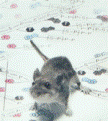Papers in the Biological Sciences

Jay F. Storz Publications
Adaptive Functional Divergence among Triplicated α-Globin Genes in Rodents
Document Type
Article
Date of this Version
3-2008
Abstract
The functional divergence of duplicated genes is thought to play an important role in the evolution of new developmental and physiological pathways, but the role of positive selection in driving this process remains controversial. The objective of this study was to test whether amino acid differences among triplicated a-globin paralogs of the Norway rat (Rattus norvegicus) and the deer mouse (Peromyscus maniculatus) are attributable to a relaxation of purifying selection or to a history of positive selection that has adapted the gene products to new or modified physiological tasks. In each rodent species, the two paralogs at the 59-end of the a-globin gene cluster (HBA-T1 and HBA-T2) are evolving in concert and are therefore identical or nearly identical in sequence. However, in each case, the HBA-T1 and HBA-T2 paralogs are distinguished from the third paralog at the 39-end of the gene cluster (HBA-T3) by multiple amino acid substitutions. An analysis of genomic sequence data from several rodent species revealed that the HBA-T3 genes of Rattus and Peromyscus originated via independent, lineage-specific duplication events. In the independently derived HBA-T3 genes of both species, a likelihood analysis based on a codon-substitution model revealed that accelerated rates of amino acid substitution are attributable to positive directional selection, not to a relaxation of purifying selection. As a result of functional divergence among the triplicated a-globin genes in Rattus and Peromyscus, the red blood cells of both rodent species contain a mixture of functionally distinct a-chain hemoglobin isoforms that are predicted to have different oxygen-binding affinities. In P. maniculatus, a species that is able to sustain physiological function under conditions of chronic hypoxia at high altitude, the coexpression of distinct hemoglobin isoforms with graded oxygen affinities is expected to broaden the permissible range of arterial oxygen tensions for pulmonary/tissue oxygen transport.


Comments
Published in Genetics, Vol. 178, 1623-1638, March 2008, Copyright © 2008 The Genetics Society of America. doi:10.1534/genetics.107.080903
Since the GSA does not permit archiving of their copyrighted content, the link will take you to the open-access version available on their website, @ http://www.genetics.org/cgi/reprint/178/3/1623 [full-text PDF file], or http://www.genetics.org/cgi/content/abstract/178/3/1623 [abstract page with links].